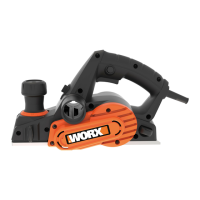10
Planer EN
ACCESSORIES
Parallel guide 1
TCT blades (on machine) 2
Wrench (on machine) 1
Dust bag 1
We recommend that you purchase your accessories
from the same store that sold you the tool. Refer to
the accessory packaging for further details. Store
personnel can assist you and offer advice.
OPERATING
INSTRUCTIONS
NOTE: Before using the tool, read the
instruction book carefully.
Intended Use
The machine is intended for planning of firmly
supported wooden materials, such as beams and
boards. It is also suitable for beveling edges and
rebating.
ACTION FIGURE
BEFORE OPERATION
Dust extraction guide switch
NOTE: Dust extraction port can be
adjusted to the right or left side by
turning the dust extraction guide
switch (11) to the left or right.
See Fig. A1
Fitting a dust bag See Fig. A2
Empty the dust bag See Fig. A3
Baseplate stand See Fig. B
Assembling the parallel guide See Fig. C1
Adjusting the parallel guide
NOTE: Loosen adjusting knob (15)
and adjust the required rebating width
(Max. 82 mm).
See Fig. C2
Adjusting the rebate guide
NOTE: Set the required rebate depth
using the indicator line (a) and the
mark on the planer housing next to the
line (Max. 12.7 mm).
See Fig. D
Adjusting the cutting depth
NOTE:
• Smaller cutting depth of 0-3 mm is
best for most surface planning or
rebating.
• Rotate the depth adjustment knob
(8) to set the required cutting depth
on the scale. Scale graduation = 0.5
mm.
See Fig. E
OPERATION
Safety ON/OFF switch See Fig. F
Standard surface planning See Fig. G1
Planning with the parallel guide See Fig. G2
Edge chamfering See Fig. H
AFTER USE
Blade fitting and changing - To remove
the old blade
WARNING: Remove power
cord from the socket before
carrying out any adjustments or
changing blades.
The blade has two cutting edges, which
can be reversed.
NOTE:
• Dull and worn blade cannot be
reground and must be replaced.
• The planer blades may not be
re-sharpened. Do not attempt to
sharpen or use re-sharpened blades
of any kind.
• Use only blades designated for
use with this model, because
other blades will cause vibration,
decrease performance and may not
clamp securely in the blade holder.
• There is no need to remove the
blade clamping element as this
can change the factory settings for
cutting blade height control.
See Fig. I1,
I2, I3
Blade fitting and changing - Installing a
new blade
NOTE:
• Before reinserting a new or reverse
blade, always clean both the blade
and the blade seat if dirty.
• After slide the blade into the blade
holder in the correct orientation,
re-tighten the 3 screws again by the
wrench.
• Before starting, rotate by hand to
check the roller is free to rotate.
See Fig. I4

